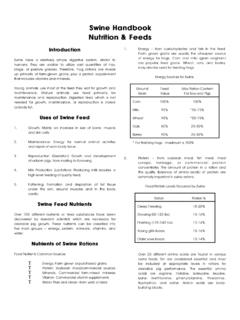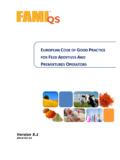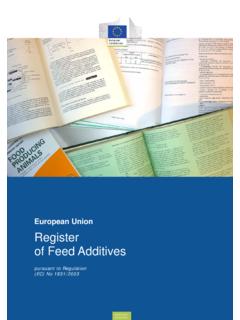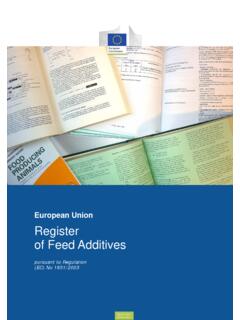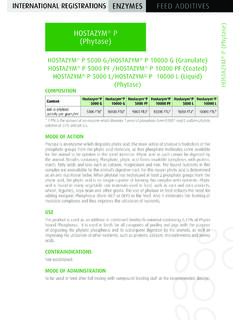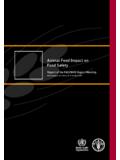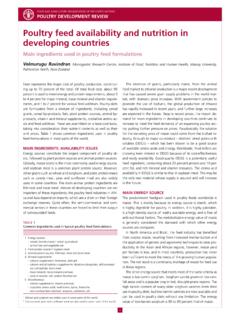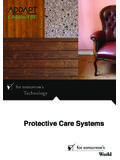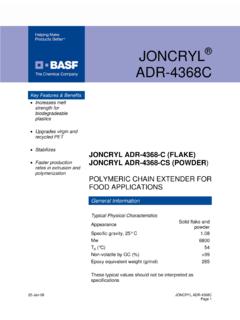Transcription of Swine Handbook Nutrition & Feeds
1 Swine HandbookSwine HandbookNutrition & FeedsNutrition & FeedsIntroductionIntroductionSwine have a relatively simple digestive system, similar tohumans. They are unable to utilize vast quantities of hay,silage, or pasture grasses. Therefore, hog rations are madeup primarily of farm-grown grains, plus a protein supplementthat includes vitamins and minerals. Young animals use most of the feed they eat for growth andmaintenance. Mature animals use feed primarily formaintenance and reproduction. Digested feed which is notneeded for growth, maintenance, or reproduction is storedas body of Swine FeedUses of Swine : Mainly an increase in size of bone, muscleand skin : Energy for normal animal activitiesand repair of worn body (Gestation): Growth and developmentof unborn pigs, from mating to Production (Lactation): Producing milk requires ahigh-level feeding of quality feed .
2 : Formation and deposition of fat tissueunder the skin, around muscles and in the feed NutrientsSwine feed NutrientsOver 100 different nutrients or feed substances have beendiscovered by research scientists which are necessary fordesirable pig growth. These nutrients can be classified intofive main groups -- energy, protein, minerals, vitamins, of Swine RationsNutrients of Swine RationsFood Nutrients Common Sources Energy: Farm grown or purchased grains Protein: Soybean meal/commercial sources Minerals: Commercia/ farm-mixed minerals Vitamin: Commercial vitamin supplements Water: Pure and clean--from wells or -- from carbohydrates and fats in the grown grains are usually the cheapest sourceof energy for hogs.
3 Corn and milo (grain sorghum)are popular feed grains. Wheat, oats, and barleymay also be used for feeding Sources for Swine GroundGrainFeedValueMax Ration ContentFor Sow and PigsCorn100%100%Milo95%*50-75%Wheat95%*5 0-75%Oats80%25-50%Barley90%25-50%* For finishing hogs maximum is 100% -- from soybean meal, fish meal, meatscraps, tankage, or commercial proteinconcentrates The amount of protein in a ration andthe quality (balance of amino-acids) of protein areextremely important in Swine Protein Levels Required by SwineRationProtein %Creep Feeding18-20%Growing (50-125 lbs)15-16%Finishing (125-240 lbs)
4 13-14%Young gilts-boars15-16%Older sows-boars13-14%Over 20 different amino acids are found in variousswine Feeds . Ten are considered essential and mustbe included at appropriate levels in rations fordesirable pig performance. The essential aminoacids are arginine, histidine, isoleucine, leucine,lysine, methionine, phenylolanine, threonine,tryptophan, and valine. Amino acids are body-building -- from grain and protein sources butprimarily from mineral supplements. Over 15 differentminerals are essential for Swine growth. Calcium,phosphorus and iodized salt (iodine, sodium, andchlorine) make up the largest mineral other important minerals (iron, copper, zinc, andmanganese) can be supplied in a trace-mineralizedsalt combination.
5 Mineral Mixture--Pasture Self Feeding40 pounds feed grade limestone40 pounds Dicalcium phosphate20 pounds Trace mineralized saltConfinement rearing of hogs dictates that all of therequired major and minor minerals be included inswine rations. A calcium-phosphorus deficiency orimbalance can create serious health problems withinconfined sow -- from direct sunshine, dehydrated alfalfameal, green pasture, or synthetic sources such asvitamin premixes. Vitamins regulate many bodyfunctions and are essential for rapid growth of A affects the eye and normal vision, VitaminD particularly affects phosphorus-calciummetabolism, and the B-Vitamins are responsible forthe nervous system.
6 Vitamins must be included in theration of confinement-reared -- from clean wells or lakes. Water is the mostimportant ingredient of all. It is necessary to maintainbody temperature, to carry digested feedthroughout the body and to remove body consumption will vary with environmentaltemperatures. Pigs will normally drink twice as muchwater on a pound basis as their daily feedconsumption. Approximate Daily Water and feed ConsumptionPoundsPig WaterDry pounds of water is about one -- from antibiotics, arsenicals, and sulfa orcopper compounds. feed additives are used in pigrations to improve daily gain and feed antibiotics are needed, two different kinds canbe combined for greater effectiveness and used inrotation to increase responsiveness.
7 Arsenicals andsulfa compounds are frequently used in combinationwith antibiotics. Copper compounds may be usedfor "spot treatment" situations rather than as aroutine feed use dry feed before weaning more efficiently than inlater growth stages. Several commercially prepared, early-weaning (three to four weeks) and creep rations areavailable. Select a pelleted feed if possible. Feeds with sugaror artificial sweeteners mixed within the pellet are preferred tosugar coated pellets. The rations shown below may be usedwhen farm-mixed rations are Mixed Pig Rations (lbs.)Young Pig18%Baby Pig20%100020025050050-100 Yellow CornRolled OatsDried WheySoybean MealVitamin/Mineral Pack90020025060050-100 Farm grown pigs usually respond to weaning stress and initialfeeding with less difficulty than do purchased "feeder pigs.
8 "In either case, the digestive tract must adjust to totally dryfeed intake. A 16 percent protein ration is normallyrecommended for the 45- to 50-pound pig until it reaches125 pounds. Some successful feeders have used 200 poundsof whole oats in a ton of ground mixture in order to reducedigestive disturbances at the beginning of this feedingperiod. Suggested Rations Different Protein SourcesIngredient (lbs.) 16%14%Yellow corn (8%)15561667 Soybean meal (44%)444333 Mineral/Vitamin Premix50-10050-100 Yellow corn (8%)1500 1625 Supplement (40%)500 375 Mineral/Vitamin Premix50-10050-100 Yellow corn (8 %)1429 1571 Supplement (36%)571 429 Mineral/Vitamin Premix50-10050-100 Complete mixed rations containing 14 percent crude proteinprovide essential nutrients for optimum growth during thefinishing stage.
9 Smaller-framed, finer-boned type animalsfrequently need to be marketed at 215-220 pounds where aslarge-framed individuals may grow to 245-250 pounds beforebecoming feed Requirement For Weight ChangesWeight Change in PoundsPounds feed perPounds Gain25 to 7575 to 125125 to 175175 to 225225 to hogs during the finishing stage (125 pounds tomarket weight) is a low-labor enterprise when self-feeders andautomatic waterers are utilized. In extremely hot weather,heat stress can be serious since hogs have a poorlydeveloped sweating mechanism. Water from flush alleysand/or sprinkler systems will allow animals to lose body heat,due to evaporation.
10 Forty- to 50-pound pigs require three to four square feet perhead in confined facilities with slotted floors or flush alleys and10 to 12 square feet on solid concrete floors. Placement offeed on the pen floor during the initial seven to 10 days willnormally stimulate pigs to develop desirable housekeepinghabits in flush-type buildings. A 20- to 30-gallon barrel or self-waterer can be used to provide medicated water to youngpigs when an in-line system is not available. Suggested Space for Confined PigsAnimal Wt. (lbs.) Sq feet/pig*25 to 5050 to 100100 to 150150 to 2503468* Under hot-humid conditionsadditional space or increased airflow is operators frequently develop high quality sowherds when performance tested, purebred boars are utilizedin rotational, cross-breeding programs.
